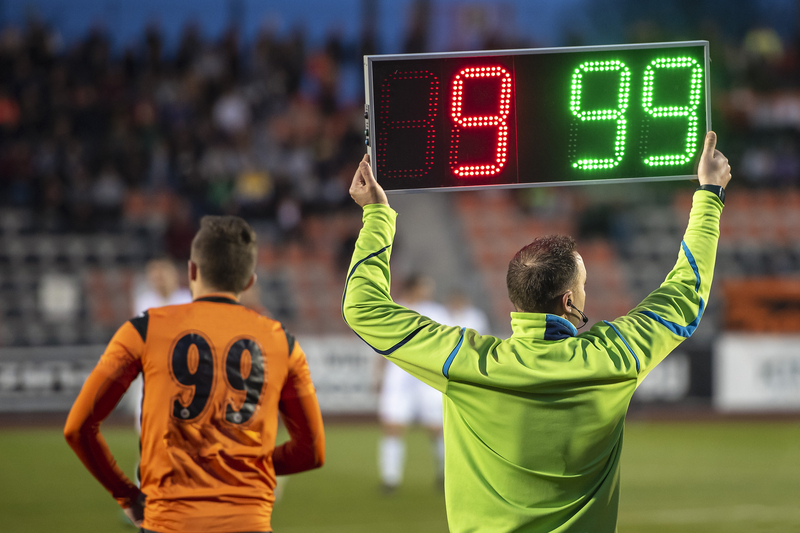Last updated on November 8th, 2023 at 09:03 am
Professional soccer games are 90 minutes of official game time between two teams with eleven players on the pitch. During those 90 minutes of gameplay, soccer teams can make substitutions to give players rest, bench struggling players, and more. To make a substitution, the referee must recognize the new player coming in and know who they are replacing, and subs can only occur during a stoppage in action.
So how many substitutions does a professional soccer team get per game? Do college, high school, and youth soccer leagues allow an unlimited number of subs during a match? Can they come back in if a soccer player is subbed out of a game? How do substitute players alert the referee that they are coming into the game, so they don’t receive a yellow card?
Here is the complete breakdown of how substitutions work in soccer (association football).
What are the Etiquette Rules of a Soccer Substitution?
If you are the player coming off the bench to replace another player, you can’t enter the soccer pitch until the referee signals that you can. If players decide to join the play before the referee signals the change, they will get a yellow card.
Next, the player coming into the game must wait until the player they are substituting leaves the pitch of play entirely. From there, they have to wait for the referee to signal that they can come into the game before going on the field.
What Laws of the Game Dictate the Number of Subs During a Match?
Rule 3 of the Laws of the Game allows up to three substitutions during a soccer match. However, a player who receives a red card at any point during that match can’t be subbed out, which means that team plays with one less player.
During the Covid-19 (coronavirus) pandemic season, a rule change went into effect to increase the number of substitutions in soccer to five. However, the Premier League kept their three sub-rule and did not opt for the five even though they had the chance during the pandemic season.
Why Make a Substitution During a Soccer Game?
There are many reasons to remove a player via a substitution during a soccer game. First, an injured player needs to be removed from the game, which means another player needs to go in their place to keep eleven players on the field. As long as the team did not use all three subs, they can make that change and keep eleven players on the field.
Second, some players might be struggling during the game against the opposing team, either on offense or defense. If the coach notices that a player is getting beat to the ball or having a hard time defending an opposing player, they could make that change.
Third, soccer managers might sub out a player if they receive a yellow card during a game. If that same player receives two yellow cards during that game, they get a red card, which means they are ejected from the match. Getting ejected from the game means that the team can’t sub in a new player to replace them, so some coaches play conservatively and sub out that player for someone else to not chance that red card.
Can a Player Come Back into a Game After a Substitution?
Per the soccer rules in Law 3, once a player comes out of a game via a substitution, they can’t come back to play for the remainder of the game. This type of soccer rule is the same in baseball, where a player can’t come back to play in a match once another player comes in for them during that game.
However, college, high school, and youth soccer leagues allow players to return to the field at least once after getting replaced.
Do the Number of Subs Reset in Extra Time?
During extra time, soccer clubs receive a fourth substitution to use if they choose. This fourth sub-option was a recent addition to soccer during the 2016 Summer Olympics. A fourth substitution during the extra time was also allowed in the 2018 FIFA World Cup elimination rounds.
What Does a Super-Sub Mean in Soccer?
A super-sub means a player who was not in the starting line-up to start the game but comes into the match and has a positive impact. For example, let’s say that the backup goalkeeper went into the game for Manchester United due to an injury to the starting goalkeeper. That new goalkeeper could have a clean sheet during the game, which meant they did not allow any goals. They will get the super-sub mention since they came into the game from the bench and positively impacted them.
Do Friendly Matches Allow More Substitutions to Occur?
During a Friendly Match, since the games and individual achievements don’t matter, more subs than three are allowed in competitions. Some coaches like to put in more bench players towards the end of the game during these matches.
How Many Subs in College Soccer Leagues?
NCAA College Soccer allows up to eleven substitutions during a game. In addition to that, soccer players can re-enter the game one more time after being subbed.
How Many Substitutions in High School Soccer Game?
High School Soccer games have unlimited substitutions during a match. The goal of the high school sport wants to include more players on the field to play.
How Many Substitutions in Youth Soccer Game?
Youth soccer leagues have unlimited substitutions during a game. The endless subs allow more players to get into the game, which is the entire point of youth sports. Since winning these games isn’t the goal, coaches use many subs to allow more players to play.
Conclusion: How Do Substitutions Work in Soccer (Association Football)?
In summary, professional soccer games today allow three subs during a regular-season match. When the game goes into extra time, teams can also make a fourth substitution.
When it comes to college, high school, and youth soccer leagues, the sub rules are different from the pros. College soccer allows eleven subs, while high school and youth leagues allow unlimited replacements.
Similar Posts:
How Many Players are on a Soccer Team?
How Long is Extra Time in Soccer?
Greg Kristan, owner of The Stadium Reviews, LLC and TM Blast, LLC, brings his extensive experience visiting over half of the MLB ballparks, along with numerous MLS, NHL, NBA, and NFL venues, to provide in-depth coverage on the bag policy, food options, and parking. He has also been interviewed about his experiences on several sports podcasts.








